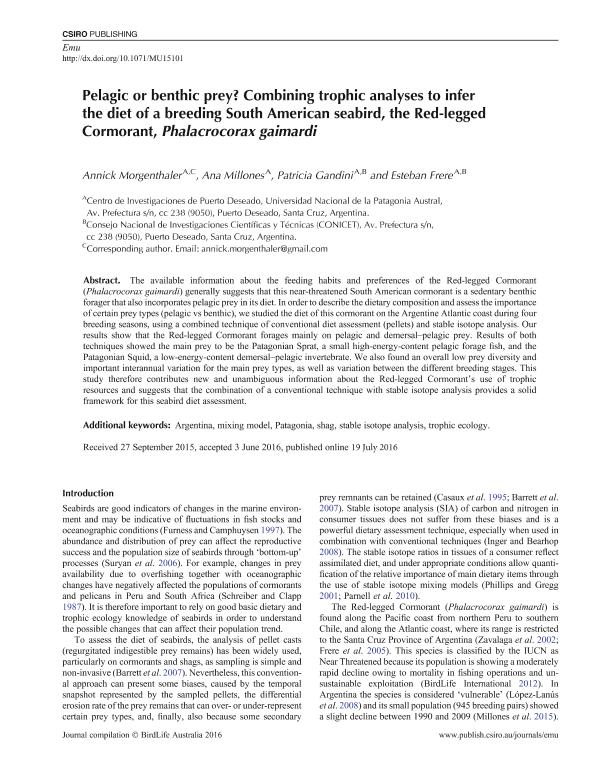Mostrar el registro sencillo del ítem
dc.contributor.author
Morgenthaler, Annick

dc.contributor.author
Millones, Ana

dc.contributor.author
Gandini, Patricia Alejandra

dc.contributor.author
Frere, Esteban

dc.date.available
2020-09-18T12:28:18Z
dc.date.issued
2016-07
dc.identifier.citation
Morgenthaler, Annick; Millones, Ana; Gandini, Patricia Alejandra; Frere, Esteban; Pelagic or benthic prey? Combining trophic analyses to infer the diet of a breeding South American seabird, the Red-legged Cormorant (Phalacrocorax gaimardi); Csiro Publishing; Emu; 116; 4; 7-2016; 360-369
dc.identifier.issn
0158-4197
dc.identifier.uri
http://hdl.handle.net/11336/114282
dc.description.abstract
The available information about the feeding habits and preferences of the Red-legged Cormorant (Phalacrocorax gaimardi) generally suggests that this near-Threatened South American cormorant is a sedentary benthic forager that also incorporates pelagic prey in its diet. In order to describe the dietary composition and assess the importance of certain prey types (pelagic vs benthic), we studied the diet of this cormorant on the Argentine Atlantic coast during four breeding seasons, using a combined technique of conventional diet assessment (pellets) and stable isotope analysis. Our results show that the Red-legged Cormorant forages mainly on pelagic and demersal-pelagic prey. Results of both techniques showed the main prey to be the Patagonian Sprat, a small high-energy-content pelagic forage fish, and the Patagonian Squid, a low-energy-content demersal-pelagic invertebrate. We also found an overall low prey diversity and important interannual variation for the main prey types, as well as variation between the different breeding stages. This study therefore contributes new and unambiguous information about the Red-legged Cormorant's use of trophic resources and suggests that the combination of a conventional technique with stable isotope analysis provides a solid framework for this seabird diet assessment.
dc.format
application/pdf
dc.language.iso
eng
dc.publisher
Csiro Publishing

dc.rights
info:eu-repo/semantics/openAccess
dc.rights.uri
https://creativecommons.org/licenses/by-nc-sa/2.5/ar/
dc.subject
ARGENTINA
dc.subject
MIXING MODEL
dc.subject
PATAGONIA
dc.subject
SHAG
dc.subject
STABLE ISOTOPE ANALYSIS
dc.subject
TROPHIC ECOLOGY
dc.subject.classification
Ecología

dc.subject.classification
Ciencias Biológicas

dc.subject.classification
CIENCIAS NATURALES Y EXACTAS

dc.title
Pelagic or benthic prey? Combining trophic analyses to infer the diet of a breeding South American seabird, the Red-legged Cormorant (Phalacrocorax gaimardi)
dc.type
info:eu-repo/semantics/article
dc.type
info:ar-repo/semantics/artículo
dc.type
info:eu-repo/semantics/publishedVersion
dc.date.updated
2020-09-17T14:41:11Z
dc.journal.volume
116
dc.journal.number
4
dc.journal.pagination
360-369
dc.journal.pais
Australia

dc.description.fil
Fil: Morgenthaler, Annick. Universidad Nacional de la Patagonia Austral. Unidad Académica Caleta Olivia. Centro de Investigaciones Puerto Deseado; Argentina. Consejo Nacional de Investigaciones Científicas y Técnicas; Argentina
dc.description.fil
Fil: Millones, Ana. Universidad Nacional de la Patagonia Austral. Unidad Académica Caleta Olivia. Centro de Investigaciones Puerto Deseado; Argentina
dc.description.fil
Fil: Gandini, Patricia Alejandra. Consejo Nacional de Investigaciones Científicas y Técnicas; Argentina. Universidad Nacional de la Patagonia Austral. Unidad Académica Caleta Olivia. Centro de Investigaciones Puerto Deseado; Argentina
dc.description.fil
Fil: Frere, Esteban. Universidad Nacional de la Patagonia Austral. Unidad Académica Caleta Olivia. Centro de Investigaciones Puerto Deseado; Argentina. Consejo Nacional de Investigaciones Científicas y Técnicas; Argentina
dc.journal.title
Emu

dc.relation.alternativeid
info:eu-repo/semantics/altIdentifier/doi/http://dx.doi.org/10.1071/MU15101
dc.relation.alternativeid
info:eu-repo/semantics/altIdentifier/url/https://www.tandfonline.com/doi/abs/10.1071/MU15101
Archivos asociados
